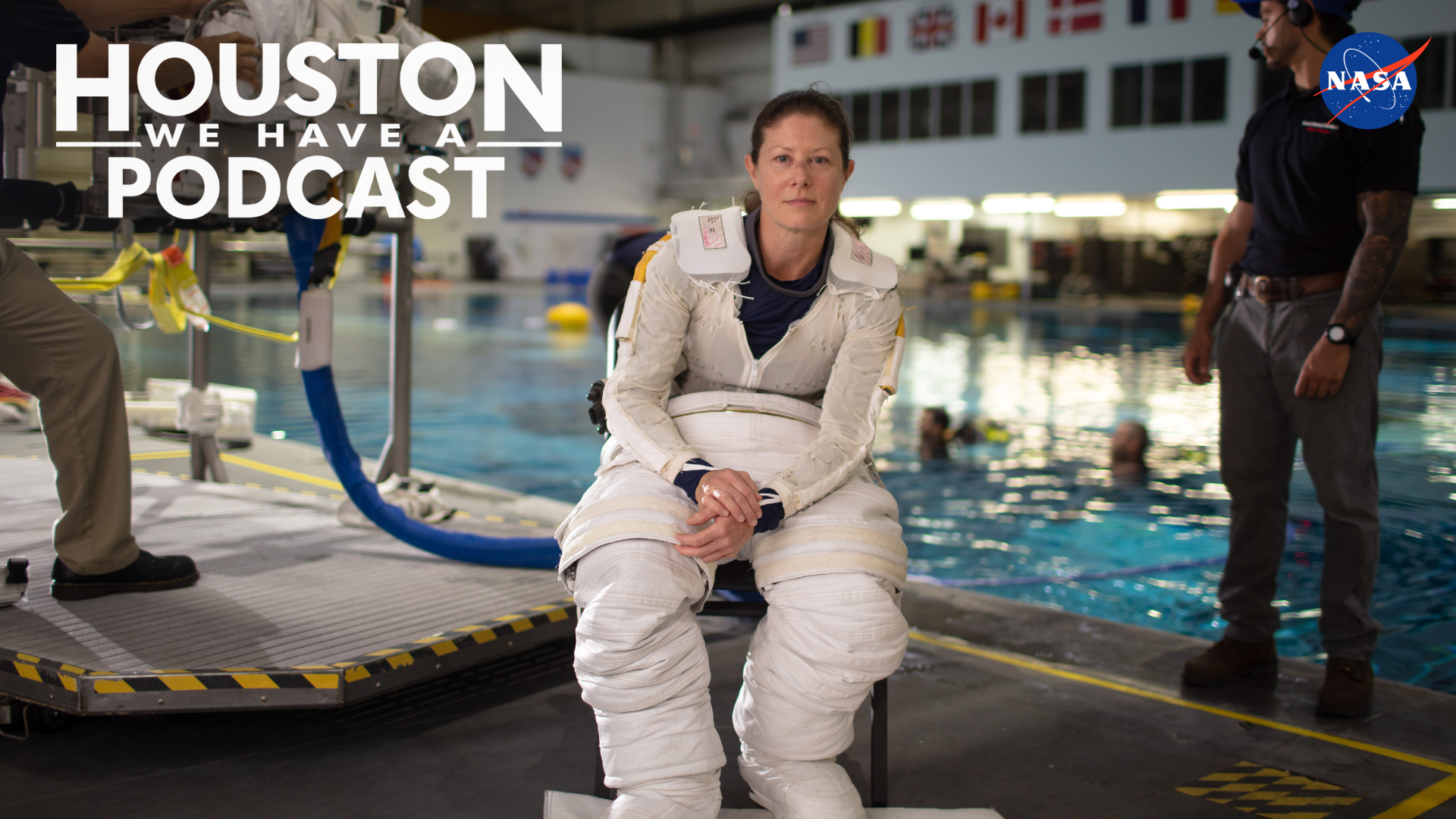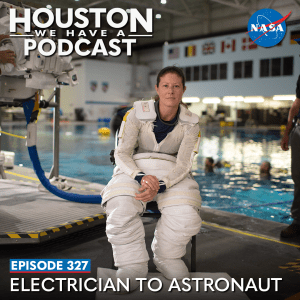
From Earth orbit to the Moon and Mars, explore the world of human spaceflight with NASA each week on the official podcast of the Johnson Space Center in Houston, Texas. Listen to in-depth conversations with the astronauts, scientists and engineers who make it possible.
On episode 327, NASA astronaut Tracy C. Dyson discusses her background and anticipation as she looks ahead to the beginning of her third spaceflight later this month. This episode was recorded on September 25, 2023.

Transcript
Host (Leah Cheshier): Houston, we have a podcast! Welcome to the official podcast of the NASA Johnson Space Center, Episode 327, “Electrician to Astronaut.” I’m Leah Cheshier, and I will be your host today. On this podcast, we bring in the experts, scientists, engineers, and astronauts, all to let you know what’s going on in the world of human spaceflight. Tracy C. Dyson was selected by NASA as an astronaut candidate in 1998. As a PhD in chemistry with an impressive research background into the Earth’s atmosphere and now a NASA astronaut, Tracy is looking forward to her third mission to the International Space Station. Born in Arcadia, California, Dyson earned a Bachelor of Science degree in chemistry from California State University Fullerton in 1993, and a PhD in chemistry from the University of California Davis in 1997. Prior to joining NASA, Dyson designed, constructed and implemented electronics and hardware associated with the study of atmospheric gas phase chemistry, and has developed and presented numerous papers on methods of chemical ionization for the spectral interpretation of trace compounds. At the time of her selection in 1998, she was completing her postdoctoral fellowship in environmental science to study atmospheric chemistry at the University of California, Irvine.
Dyson is set to fly on the Soyuz MS-25 mission to the International Space Station for a six-month mission. Launching from the Baikonur Cosmodrome Launch Site 31 in Kazakhstan, she’ll be joined by Roscosmos cosmonaut Oleg Novitsky and spaceflight participant Marina Vasilevskaya of Belarus, both of who will spend approximately 12 days aboard the orbital complex. This will be Dyson’s third flight assignment of her astronaut career, and she scheduled to launch in March 2024. Now that you have just a glimpse into the wealth of experiences of Tracy Dyson, enjoy this chat with the seasoned astronaut herself.
[Music]
Host: Tracy, I am so excited that you’re here today. Thank you so much for joining me on Houston We Have a Podcast.
Tracy C. Dyson: Thank you, Leah. I’m super excited to be here.
Host: So we’ll start off in the beginning, your background. Let’s talk about life when you were growing up. You were born in Arcadia, California. Did you stay there for long?
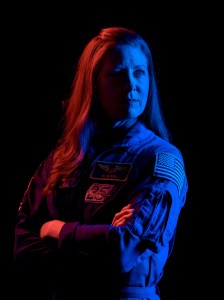
Tracy C. Dyson: No, no. That was an area where my parents grew up, went to school, but I grew up all around Southern California in different areas and as my dad’s company grew and our income grew, then the neighborhoods became a little nicer. So I grew up all around Southern California.
Host: So there are some NASA centers in California. Did you ever make a pit stop? Did you ever get to visit when you were a kid?
Tracy C. Dyson: I didn’t. I hate to admit that. I lived a much different life growing up than I do now, surrounded by all things space. The closest I got to space agencies and talk of space was when I’d go out to the high deserts of Southern California and ride motorcycles and I’d lay on my trailer and look up at the vast amount of stars in the dark sky. And that was my space center.
[Laughs]
Host: Wow, that’s really amazing. We’re losing those dark sky spaces.
Tracy C. Dyson: We are.
Host: So I think that’s a really sweet memory. I know something really important in your childhood and then even into now is working with your dad in his electrical company. Can you walk me through how that started? Can you tell me, you know, how that has kind of shaped your path today?
Tracy C. Dyson: Yeah, the problem is I don’t know when to stop talking about it, cause the older I get, the more experienced I get doing this work, the more I realize just what a foundation that provided for me. Both my parents, the fact my mother allowed me to go on a job site when I was a wee little girl, she had a lot of courage and trust in my dad, and plus my dad taking on a high energy little girl on a job site with him. I just commend both my parents. But my dad recognized early on that I had like an aptitude, and I enjoyed what he was doing and I had energy, so he put me to work. So I was about seven years old—my earliest memory is being seven years old when I was actually put to work.
I’d gone to job sites with my dad before then, just playing around with my toys and my roller skates and running around like a troublemaker. But then dad started giving me jobs to do and I started out with simple hand tools. I would strip wire and make up receptacles. Then the better I got at that, dad would have me climbing ladders cause I wasn’t afraid of heights. And so I was installing lights. Then I started wiring up panels and pulling wire and doing all sorts of work. And I was about 15, 16 years old when my dad started letting me go, cause I could drive, and so I could go on service calls. So folks would have problems with their office buildings or their stores, and they’d need an electrician, they’d call us. And dad was busy either running the company or overseeing a job with the rest of the electricians so he could send me out on a service call. So I’d go and find out what their problem was and do what I could to fix it. And continued on like that, working for my dad even on the job sites, but also working service calls.
Host: That’s impressive. So you did this, you know, through high school too, but you also played sports, right? So how do you balance that? That’s a really busy schedule.
Tracy C. Dyson: Right. So, luckily, I’ve had such supportive parents and the way construction works, I worked for my father for all of my holidays, all of my weekends that I wasn’t engaged in sports and I was in sports all year round, but track primarily. And so those are weekend meets. But any kind of vacation that I had and summer breaks, I worked for my dad. But also construction, you bid a job, you do a job, and then you wait for a little while for another job to come. And so my dad was, and both my parents were, pretty involved in my sports as well. So yeah, it was a busy life, but I think you need that when you got a lot of energy to keep yourself from getting in trouble.
Host: I agree. I agree. What’d you run in track?
Tracy C. Dyson: I was a sprinter and a long jumper.
Host: Impressive. And you did that in college too, right?
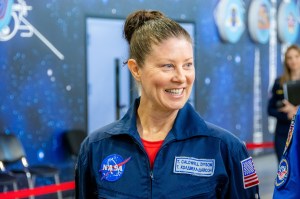
Tracy C. Dyson: I did. All four years that I could, I competed in track and field, so it was kind of my gig to run fast.
Host: Do you still run?
Tracy C. Dyson: No. I try, but I don’t run. But if I did run, I like to say I run meters, not miles. And so I like to sprint still and I’ve got two energetic dogs, Rhodesian Ridgebacks, and they like to sprint, so I get my little bursts out with them. But I wouldn’t say that I’m quite as routine as I used to be.
Host: I love it. So you mentioned college and I found it really interesting that you did all of this electrical work growing up, and then you chose chemistry in college.
Tracy C. Dyson: I know, I didn’t see it coming either. But when I was in high school, there was a teacher, his name was Mr. Smith. I’ll never forget him. I took chemistry from him, and I just loved it because it answered all of the questions that I had growing up. Like, why is the sky blue? And I really wanted to know. I mean, I wasn’t just asking. And chemistry answered that. And, you know, why does water boil? Chemistry answers that. And so I think it was then that I started to get kind of motivated to learn more about chemistry.
Host: I’m just going to read off some of what is in your bio. You studied atmospherically relevant gas phase chemistry by designing and building a laser ionization time of flight mass spectrometer. What does that mean to be the person who did not study chemistry?
Tracy C. Dyson: Yeah. You know, that word that you just described is a combination of my construction skills as well as my love of chemistry. I think when you love something, you are so motivated to understand it, that you really plow through the parts that you don’t understand. And I think it breaks down your barrier of ego and forces you to ask questions. So if there’s any success that I’ve had in life, it’s because I’ve had to expose my ignorance and ask questions, and that’s exactly what I did. So all of that stuff that I did in undergrad and graduate school with chemistry, building and designing components and using it to get into the molecular level of reactions to see what’s going on at a level that you need special detectors to understand. Just really cater to my inquisitive, though ignorant, mind that wanted to understand more and my love for tools and putting things together and solving problems. It was just a really great combination for me.
Host: So these all seem to build on the subject of atmospheric chemistry. That was your postdoc, correct?
Tracy C. Dyson: Yes, yes. Thanks. That was where I worked for Barbara Finlayson-Pitts. She’s the queen of atmospheric chemistry. So I was really blessed to have somebody as knowledgeable and experienced as she guiding me through this project. I got to use a lot of my skills that I came from my graduate career, which is in mass spectrometry and lasers and ultra-high vacuum systems. And so I got to apply some of that knowledge, as well as some pretty sophisticated chemistry techniques using natural isotopes. And things like that have such a beautiful story to tell in harmonics and just the way nature follows a harmony that you wouldn’t know unless you interrogated it this way. And so it just really combined a lot of fascinations that I had. I think I’m just rambling now, but—
Host: I’m in awe. It’s amazing. So, is that why you chose atmospheric chemistry? You know, did something always point you to that specific field?
Tracy C. Dyson: I think actually living in Southern California, atmospheric chemistry is a big deal because of the location. In Southern California where I was, we’re in a basin, and so smog was a big deal. Like I grew up with smog alerts, like where some kids in the north have to stay home from school because of storms and snow. We had to stay home because the smog was too bad. And so I’d like to paint a better picture, but it was really because there’s just a lot of smog in Southern California that people were wanting to fix this problem. And so I happened to gravitate towards solving problems of an atmospheric nature. Plus, once I realized what a vacuum was, more than just that thing that you drag on the floor and pick up particles, like it is like the vacuum of space, what that really means, and what molecules do in a vacuum, it just blew my mind. The more I understood, the more interesting chemistry became to me. So yeah, I kind of gravitated to it, but I think it was all location because it was a problem that the state was willing to tackle. I did all of my education in California, so it was sort of like, what else would you study? But I was for chemistry.
Host: So with all of this buildup, was astronaut in mind at any point during this?
Tracy C. Dyson: The whole astronaut thing was sort of like I didn’t know how I was going to get there. I wanted to be an astronaut. And people, when they’d ask me what I wanted to be, and when I realized that’s what it was, I was about 16. And I talk about it like real serious, like, I want to be an astronaut, and there’s some people who would embrace that and ask me like real serious questions. And there were some who were skeptical, of course, like no one ever makes that. Then I’d get people telling me what I needed to do in order to become an astronaut. And some of that involved going into the military, things that were not on my radar. But somehow I felt like I’ll get there, but I’m just going to keep pursuing the things that I enjoy doing.
I didn’t even, at the time that I’d said I want to be an astronaut, did I think about even getting a PhD. And it wasn’t until I was an undergraduate and I went to a college, Cal State, Fullerton is an undergraduate institution, but to their credit, especially in their science department, they really emphasized undergraduate researchers and research. And what they did was they prepare undergraduates to go to graduate school. And because of the preparation I got there, I hit graduate school in a laboratory like I knew what I was doing. I didn’t just get there and then have to learn how to operate in a laboratory or even run one. I just knew what I was doing. And it was my undergraduate research advisor who asked me, “So what do you want to do with this degree?” And I’m like, “I don’t know. What do I want to do with it? I just love chemistry.” And he’s like, “Well, have you thought about graduate? You want to be an astronaut?” Of course, that came out, but he was like, “You want to be an astronaut, so have you thought about getting a PhD?” And I was like, “Oh, no, no, that’s for really smart people.” And he’s like, “Well, you know, you’ve got to be smart, but you’ve just got to work hard.” And I’m like, “You’ve just got to work hard? I mean, I can do that.” And he’s like, “Besides that, you get to defer your loans.” And I was like, “Oh, I’m totally there.” And so, he really talked me into it. It was the furthest thing from my mind.
To top it off, once I graduated, I remember the day of graduation, we’re standing out there on our caps and gowns and we’re all saying to one another, you know, so what more can we learn? I mean, we we’re going to graduate school, but what more can we learn? We learned everything about chemistry. And then once we got into graduate school and we had to start teaching chemistry to undergraduates, we realized how much chemistry we really didn’t know. And it was just a good thing that we went on to graduate school. So, anyway, I feel like I’m rambling again, but it’s so interesting how there’s a force in my life, I’ll call it God, that guided me on a path that that was not defined by me. And if you ask me, “So you wanted to be an astronaut?” You know, I couldn’t tell you that I started out on the right path, but somehow, I ended up in the right place. And it’s been a wonderful journey.
Host: Wow. So, you know, like you said, you’ve had this kind of dream since you were 16. When NASA released that they were accepting new astronaut applications, how many times did you apply? How did you know that “this is my chance?”
Tracy C. Dyson: That again, was timing. I applied once and I was in graduate school. So it was in ‘97, and I applied, I submitted my dissertation in one month, and the following month I submitted my application to NASA because it turned out that it was just perfect timing for this selection cycle that was coming up. And I put my application in, even though some people said, “Well, you know, you don’t usually get it on your first try.” So I was like, “Well, I better get it now.” And so I did, and even when I was applying for postdoctoral positions and Dr. Finlayson-Pitts was interested in having me come work for her and she selected me. Full disclosure, I said, “I’ve just got to let you know, I submitted my application to NASA for their astronaut program, and it’s not likely that I’ll get it, but I just feel like I should let you know that before you choose me.” And she was like, “Okay, well, we’ll take that under consideration and we’ll take our chances.” And I was like, “Okay, we’ll take our chances.” And then I got selected and I had to cut my postdoc short by one year of a two-year postdoc. But I received a lot of support from Dr. Finlayson-Pitts, despite the fact that I had to leave her a year into my postdoc. So the first time I applied, I made it and it was a shock to everybody. Especially me.
[Laughs]
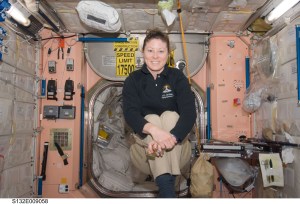
Host: Wow. But what was that call like, where were you, what did it feel like? I mean, you were shocked, but can you explain? Can you describe the moment?
Tracy C. Dyson: Oh, yeah. I can relive it over and over. And I wish that Ken Cockrell was here, cause he was the chief of the office at the time that I went through my interview. And he remembers as vividly as I do my reaction. So, I actually was at UC Irvine where I was a postdoc, and I was in my office. And at this point in the selection, as you’re waiting for the phone call, after everything’s been done, you’ve done all the trips, you’ve done all the interviews, you’ve done all of the medical exams, and now you’re waiting for them to make a decision, you’re kind of anticipating any day now the call’s going to happen and it’s either going to be good news or it’s going to be, “Hey, try again next time.”
So I was in my office and I shared an office with the fellow postdoc, and we were in it, it was a very small office, so nobody would’ve been around to even see my reaction, but the call came and I knew it was a call from outside because the phone rings a little differently when it’s an external call. So already, I’m a little bit hyped up because it’s not somebody from my other lab calling me. No caller ID. This was way back; we used ringers to identify calls. But I picked up the phone and my fellow postdoc was sitting in the desk behind me. So he heard everything, but the voice on the other end was Ken Cockrell and introduced himself. And he said, “Hi, Tracy, do you remember me?” And I was like, “Yes, I remember you.” And, and there’s also the gouge that if the chief of the astronaut office calls you, then that’s a very good sign. So I was trying to keep my composure, and he started making small talk, like chitchat, and he’s like, “So how’s that truck doing of yours?” I was like, “Oh, it’s doing good. It’s getting by.” And he’s like, “Well, you know, the weather out here is pretty good. I bet California is excellent. You probably love living there.” And I’m like, “Yeah, it’s been home,” and on and on. And he’s like, “Well, just wanted to know if you were interested in coming to Houston and joining the Astronaut Corps.” And that’s when it started. My body at that point was shaking. And I started to hyperventilate, and I didn’t know how to answer the phone. And I know this is a podcast, so you can’t see my antics over here. But I was trying to get a hold of myself, but I was shaking and I was hyperventilating, and I couldn’t really answer his question. He is like, “So do you think you might want to come to Houston?” And I was still trying to utter a word that sounded legible. And he said, “I tell you what, how about I call you back in a few more minutes?” and I’ll say, “That would be good.” And so I hung up the phone and my fellow postdoc said, “I take it that was NASA.”
[Laughs]
Tracy C. Dyson: I said, “I made it. Oh my God. I made it.” And then I busted out the door and I ran all the way up to the fourth floor where the lab and the rest of my group was and busted through the door. And I told them, I said, “I made it, I made it. Oh my God, I made Astronaut Corps.” And everybody’s jumping up and down and we’re high fiving. And then I was like, “Oh, wait, the chief’s calling back. I’ve got to go back.” And so I ran back to my office and caught him just in time. And so I was able to get my breath and he gave me a real bad time on the phone for not being able to talk right away. And then he said, “So, Tracy, I just need to let you know one more thing. Before we get off the phone, in 24 hours from now, there’ll be a press release that goes out with your name and the rest of your classmates’ names. And until then, we’d like you to limit the news to just your immediate family.” And there was this silence and he’s like, “I take it, we’re a little late for that.”
[Laughs]
Tracy C. Dyson: The science building kind of knows, cause I went screaming up the stairway. So anyway, that’s a long-winded answer to your question, but it was a very emotional reaction that I had. I couldn’t even control my shock, I think. And so it was very memorable.
Host: Wow. What a story. And I mean, thank goodness you only had to wait 24 hours before everybody else could know.
Tracy C. Dyson: Right. So yeah, I got in my truck, and I drove to see the rest of my family and give them the news in person. And it was just, it was an amazing day.
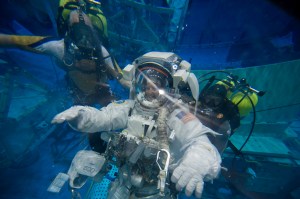
Host: Wow. And, you were the 1997 class?
Tracy C. Dyson: Yes, correct, it was ‘98, but, but we were selected in ‘97. We started in ‘98.
Host: Okay. Yeah. So since then you’ve had a really impressive career.
Tracy C. Dyson: I’ve been so fortunate to still be here 25 years later. Never saw myself being here this long, but it’s my dream career, so it’s been a real blessing.
Host: When you find it, you’ve got to keep it.
Tracy C. Dyson: That’s right.
Host: So since then, you have worked across several different spacecraft. You’ve served as a CapCom for shuttle and space station missions, and I know that you’ve had your own shuttle and space station missions. And then you’ve also worked on developing the CapCom, or I should define, this is the capsule communicator. This is the person who speaks with the astronauts when they’re either on the space station or when they’re en route to the space station. So you’ve worked on that for a development of Boeing’s Starliner capsule?
Tracy C. Dyson: Yes. So, I took that over from Mike Hopkins, who started off as the lead for the Starliner CapComs. And we were a little different in this new commercial crew regime in that Boeing had decided to contract out to NASA, the operations portion of it. And so there we were developing the CapCom corps for and in that development, it’s not just what we’ll say, but it’s deciding what kind of certifications we need, what type of CapCom. So there’s ascent, there’s entry, there’s on orbit, there’s rendezvous, there’s docking, landing. And so we had to make decisions about what made sense in terms of when we would need to be on console and talking with crew and what we had to learn as CapComs in order to fulfill that mission and support the crew.
Host: And so to talk about the spacecraft that you know best, the ones that you have flown on. You flew STS-118 in August 2007. What was that like? First spaceflight? What were your feelings? What did you work on? What were your lessons learned when you came home?
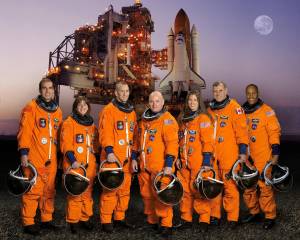
Tracy C. Dyson: Oh, well, the shuttle, gosh, it was such a—looking back, that was such a unique, not only unique, timeframe, but crew complement. I mean, you’re flying with six other people, seven of us. And depending on what we are doing, ascent, entry, rendezvous, robotics, EVA, we’re broken into smaller teams, subsets. And you are with your crew daily, and your crew becomes your family. And I mean, like brother or sister, you know, sometimes you’re hugging, sometimes you’re duking it out as you learn how to work together. As a rookie, I was so blessed. I was on the flight deck with three guys who were not just experienced, but just top notch at what they did. And I was so blessed to be the MS (mission specialist) sitting on that, the rookie sitting on the flight deck with those guys on asset and rendezvous.
So I learned so much from those guys. Just their confidence and that they trusted me to do the job I was given in either the ascent or the rendezvous portion of it. Then my fellow rookies, Barbara (R. Morgan) and Al Drew, we were just so blessed to be on that flight to dock with the space station and do the kind of work that we did to transfer elements, to help build the space station. That was the other part of the shuttle flight that was so unique, every flight was bringing something new to the space station and building it. And so you’re watching it, mission after mission, schematic after schematic. The space station was changing on a routine basis. And so it was really neat to be a part of that. And just the newness of being a rookie on a flight that is so historical, so meaningful, and has played such a role in where we are today. I look back on that with such fondness and I’m so grateful that I was around to be a part of that.
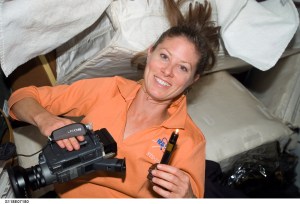
Host: And both of those flights, your first two flights, have been to the space station. So on that first shuttle flight, you were talking about building the space station, you brought up the S5 truss segment, correct?
Tracy C. Dyson: We call it “Stubby”.
Host: Why is that?
Tracy C. Dyson: Because the other one’s called “Puny,” because you don’t really see it. It’s a spacer between the solar array segments. And so it’s very important, but it’s not as prevalent when you’re looking at those fantastic photos. But yeah. Anyway, the S5.
Host: I’m sure you can always pick it out though when you see it.
Tracy C. Dyson: I totally can. Yeah.
Host: So that was 2007, you went back in 2010 as part of Expedition 23 and 24 on a Soyuz spacecraft. What was the difference in the space station? It had only been three years, right? That’s kind a short timeframe.
Tracy C. Dyson: Yeah. And wow. There seemed like the addition of Node 3, so I think Node 3 and the cupola just got there before I arrived on my space station mission. So just what comes to mind instantly is that cupola shot.
Host: Yes, I was thinking that, too.
Tracy C. Dyson: So I was fortunate to be there before we filled the cupola with a lot of things. The robotic workstation was there, but in terms of some other equipment that we have in there now, I was able to nestle myself and put up cameras and timers and remote devices so I could get that shot. But I remember being one of the first to utilize the cupola, not just gazing out the window, but actually for robotics and things like that. And what a difference a window or two or seven make. I mean, the shuttle has a great view through the cockpit windows. And they are about as large as the windows that are in the cupola. But I just couldn’t imagine the space station without this cupola. And it was such a, again, a blessing to have been there at that time to see not only our beautiful planet and the space surrounding it, but the space station itself is pretty miraculous. And it is a site to behold whether the Sun is up or the Sun is down. It’s really cool to see metal coming together in space for the first time and working. I mean, isn’t that amazing that we did that?
Host: I wish more people understood how just magnificent that is. And the thousands and thousands of people and the hundreds of thousands, probably millions, of human hours that went into making that happen. So I agree with you.
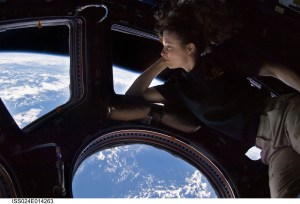
Tracy C. Dyson: Yeah. And when you see it for yourself, it’s emotional. Especially when you see a solar array turning and you know, there’s a SPARTAN at the console monitoring that. Or a CMG that’s spinning in the ADCO that’s sitting on console is like looking at torques. I mean, every bit of the space station, there is somebody in the front room, in the back room, and across the world that’s got a part in its daily operation, and you’re looking at it and you wish they could see what you could see. Like I said, it’s emotional.
Host: It’s a marvel.
Tracy C. Dyson: Right? That’s a great word.
Host: Yeah. It’s a marvel. And you also have a perspective that not everyone who visits there gets to have, because you’ve done some spacewalks.
Tracy C. Dyson: Yeah. That’s a perspective for sure. And hard to describe.
Host: What’s that like going out the hatch and the work that you did?
Tracy C. Dyson: Well, just going out the hatch itself is a mixture of personal triumph because it’s something I think every astronaut wants to do. And we train so long and hard for that. And you’re in an environment, in a training environment, that is so as close as you can get to what you’re going to do in space. But the thing that it cannot replicate or prepare you for is that view. Once you open up the hatch and you see the planet, and the only thing between it and you is this visor covering your face, and you’re just like, “This is the coolest thing ever.” And until that happens for the first time, you’re really not sure how you’re going to handle it. Are you going to like, have a giggle fit? Are you going to actually be able to work? So yeah, there’s that aspect of it. But then the environment, once you go out the hatch, you realize, “Oh my gosh, this is just like the NBL.” And then you, at least I did, I was just like, “Oh, I feel like I’m at home.” And with the exception of that fireball that comes up every now and then and makes it circuit around the globe. And then when you see that planet below and, you know, a lot of times you’re really focused on where your hands are. And it’s not often that you get to, you know, let go because you’re secured to the worksite. And then when you happen to look down at your feet, and if you’re in that orientation and you see the planet going underneath your feet, it was such clarity, I might add, it really hits you. But you have to balance your astonishment with your attention because you’ve got a job to do. And it’s not like we want to hang out outside, we want to get the job done and get back inside. So, you’re in a little bit of turmoil cause you want to really enjoy this fascinating moment in your life. But you’ve got a job to do.
Host: And you’re going back.
Tracy C. Dyson: I’m going back.
Host: It’ll be here before you know it. You’re flying on Soyuz again. You’re familiar with Soyuz, you’re ready for the mission. How do you think the space station’s going to be different? It’s been 13 years now.
Tracy C. Dyson: Yes. I’m so looking forward to seeing all of the efficiencies that have gone into operations on board since I’ve been back. I know myself and a number of my colleagues that have lived and worked from not just NASA, but all the other space agencies, we go up there and we live for an increment. We work our tail off and we find better ways to do things and we come back and share that with all the folks, the fine folks, that keep that space station operating and being productive. And changes get made. And I’m super pumped to see the kind of work that we’re doing up there now that the focus is science and technology and utilizing the space station, not just assembling it, and just even changes to the timeline and the way that it’s a different timeline, or I mean, physically, a timeline that a red line moves with your name and all your activities. And even that has changed since I was up there. And I’ll tell you what, that timeline, you live and you breathe by this timeline, and it can wear you out. It can stress you out. The changes that they’ve made to just that alone, I’m looking forward to seeing that. Just cause we’ve gotten so much smarter.
Host: So what will your duties be on the mission?
Tracy C. Dyson: Just about everything from wrench monkey to, you know, to bag handlers, you know, housekeeper. I think I’m going to do just about anything they ask me to. As a Soyuz flyer, we have to be trained as specialist on all of the U.S. systems. And so I can expect to do my share of maintenance and stuff because of that qualification, and train for spacewalks and robotics. And so ready to capture a vehicle and go out to hatch whenever I’m needed and called upon.
Host: I’m keeping my fingers crossed for you to get to go out the hatch again.
Tracy C. Dyson: Thank you. Me too.
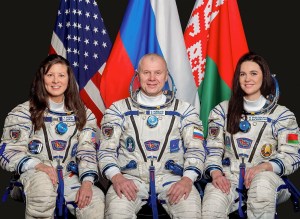
Host: I want to see you on another spacewalk. So do you have any personal goals for the mission?
Tracy C. Dyson: Personal goals? Well, I think my personal goal is to not try to fix everything on board the space station. I’m not the only one. You get up there and you take over a home and, you know, a work site from somebody else and the cargo keeps coming and things keep breaking. But we’ve got a pace of operations that have to be maintained. And so you’ve got to kind of balance your life, work up there and not get too dedicated. Your list of to-do’s, can’t get too long, because it can certainly overwhelm you while you’re up there because you just have to be ready for the unexpected. And, you know, like those spacewalks that I did on my previous mission were a very unexpected event, and it caused a halt in a lot of operations that we had been doing from the science standpoint. Then you just kind of have to be flexible. So I’m looking forward to personally just trying to keep balance up there and harmony and just really enjoy what I’m doing. And having been there before, I kind of know what to expect in that regard. So I’m hoping to maybe instill that in some of the others that I’ll be living with, that maybe this is their first time and if I can do anything to provide them peace and support, I’m super looking forward to that.
Host: I’m super looking forward to seeing you make it happen.
Tracy C. Dyson: Yeah. Thank you.
Host: And I think we’re running out of time, so we are wishing you the very best of luck for your third flight. And thank you again for coming today to tell your story. It really has been amazing to have you here.
Tracy C. Dyson: Well, thank you, Leah. It’s been a pleasure and I really enjoyed it, so I appreciate it. Thank you.
[Music]
Host: Thanks for sticking around. I hope you learned something today. You can check nasa.gov for the latest spaceflight schedules. You can also find us on nasa.gov/podcasts, as well as on Johnson Space Center social media accounts, including Facebook, X, and Instagram. Use #AskNASA on your favorite platform to submit your idea and make sure to mention it’s for Houston We Have a Podcast. This episode was recorded on September 25, 2023. Thanks to Will Flato, Dane Turner, Abby Graf, Jaden Jennings, Gary Jordan, and the astronaut scheduling team. And of course, thanks again to Tracy C. Dyson for taking the time to come on the show. Give us a rating and feedback on whatever platform you’re listening to us on and tell us what you think of our podcast. We’ll be back next week.



























